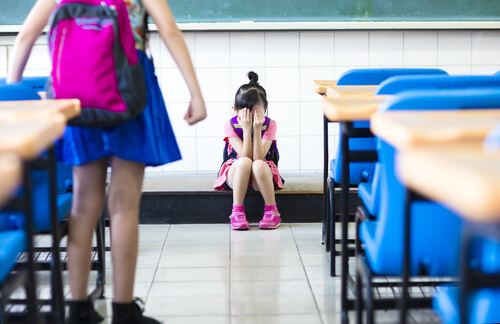5 Types of Bullying

Unfortunately bullying is a problem that occurs in many schools around the world. It can also occur in many different ways: physical and psychological are just two examples. In this article we’ll discuss five types of bullying.
If you notice strange behavior in your child, it may reflect deep problems that deserve your attention. Bullying is one of these problems.
You’ll have to sharpen your maternal instinct to notice it. Some types of bullying don’t leave marks on the skin but rather on the mind.
5 types of bullying
-
Physical bullying
This is one of the types of bullying that is a bit easier to detect. The child may have lesions or marks on their skin that show they’re suffering from some type of abuse.
This includes pushing, hitting and even situations that involve one or more aggressors.
In some cases, physical abuse can go further: it can even lead to theft or damage of possessions simply to harm the child. Children are often abused like this in public and that adds psychological damage to the victim.
Adults who are in charge need to step in, in order to deal with this type of bullying. They should engage the aggressors in dialogue to make them understand that physical violence is not the solution to anything.
If the behavior persists, the aggressor should be punished.
-
Psychological harassment
This type of bullying is a bit harder to identify. It occurs with both boys and girls. The victims of this kind of abuse usually hide the negative feelings that are caused by it.
Jokes, ridicule and hurtful words can generate important traumas and complexes.
The abuse may be based on physical differences that the victim possesses such as weight, height, ethnicity, religion or even socioeconomic status.

Adults need to be observant in order to detect this type of bullying. Words can sometimes hurt more than blows. This kind of bullying shouldn’t be allowed under any circumstances.
-
Virtual bullying
Cyber bullying or virtual bulling, is one of the most recent types of bullying to emerge. It consists of causing harm and violating a person’s privacy through digital means.
It can occur through mediums such as social media or instant messaging platforms.
This type of bullying consists of constant harassment of the victim. It can also include the spreading of false rumors or the disclosure of private materials that could seriously affect the social life of those who suffer from it.
A common and cruel method of cyber bullying is the making of lists or rankings. These lists are made to “rank” the children according to their beauty, charisma or other qualities.
In addition to promoting prejudice and a focus on outer appearance, this practice can be devastating for children who don’t appear well positioned on the lists.
Education is necessary in order to eradicate this type of behavior from the start. Children must be taught how to use technology responsibly without hurting others.
It is also healthy for parents to have a bit of control over what their children do and observe online.
In fact, there are new applications that have been launched worldwide which help parents limit the places where their children can navigate.
“Physical harassment is one of the types of bullying that is easier to detect. The child may have lesions or marks on their skin which show that they are suffering from some kind of abuse.”
-
Social bullying
This type of bullying is linked to social relationships. The victim of social bullying is often left aside during all kinds of events and activities. The victim is often ignored and not included.
This can happen in a group of friends, in soccer teams, dances or any type of activity. It also happens at birthday parties.
It may be combined with other types of bullying such as virtual harassment. The publication of photos or videos in which the child is excluded may cause them to feel bad.
In order to detect this kind of bullying, parents must be observant of sudden mood changes.
The victim may refuse to participate in group activities or they may not want to tell you what they did that day in school with their friends.
In order to prevent bullying and social exclusion, children must learn the importance of being tolerant. They should respect differences, be supportive and encourage inclusion.
Tolerance is a fundamental value but it shouldn’t only be promoted at school. Education should begin at home and parents should be responsible for its practice.
-
Sexual harassment
Although this type of bullying often occurs in adolescence, it can also occur earlier. It can be reflected through small gestures that may even seem insignificant to the aggressor.
Making reference to a person’s intimate parts, to their sexuality or forcing them to kiss someone they don’t want to are all types of sexual harassment.
It can also be manifested through obscene comments or the imposition of pornographic material.
This is a very sensitive topic and its prevention depends on both parents and teachers. The best tool to prevent sexual harassment is early and efficient sex education.
Educators and parents must understand two things. The first is that these type of behavior can affect the victim’s emotional relationships for a long period of time. It can cause a long-lasting lack of trust for others.
The second thing to understand is that the aggressor’s behavior in the case of children doesn’t necessarily make them a sex offender. Sometimes they may see it as a game and they may not understand the true consequences of their actions.

Conclusion
Childhood and schooldays are beautiful stages that mark a person’s development.
It is important that both parents and teachers guide the little ones who are going through these stages. It is their job to teach children what is right and what is wrong.
In many cases, evil is not what drives the aggressors. There may be suffering from deep psychological issues that may be the cause of their bad behavior.
If that is the case, they may also be victims. Therefore, it’s important for parents and teachers to work in all aspects to prevent all types of bullying.
Unfortunately bullying is a problem that occurs in many schools around the world. It can also occur in many different ways: physical and psychological are just two examples. In this article we’ll discuss five types of bullying.
If you notice strange behavior in your child, it may reflect deep problems that deserve your attention. Bullying is one of these problems.
You’ll have to sharpen your maternal instinct to notice it. Some types of bullying don’t leave marks on the skin but rather on the mind.
5 types of bullying
-
Physical bullying
This is one of the types of bullying that is a bit easier to detect. The child may have lesions or marks on their skin that show they’re suffering from some type of abuse.
This includes pushing, hitting and even situations that involve one or more aggressors.
In some cases, physical abuse can go further: it can even lead to theft or damage of possessions simply to harm the child. Children are often abused like this in public and that adds psychological damage to the victim.
Adults who are in charge need to step in, in order to deal with this type of bullying. They should engage the aggressors in dialogue to make them understand that physical violence is not the solution to anything.
If the behavior persists, the aggressor should be punished.
-
Psychological harassment
This type of bullying is a bit harder to identify. It occurs with both boys and girls. The victims of this kind of abuse usually hide the negative feelings that are caused by it.
Jokes, ridicule and hurtful words can generate important traumas and complexes.
The abuse may be based on physical differences that the victim possesses such as weight, height, ethnicity, religion or even socioeconomic status.

Adults need to be observant in order to detect this type of bullying. Words can sometimes hurt more than blows. This kind of bullying shouldn’t be allowed under any circumstances.
-
Virtual bullying
Cyber bullying or virtual bulling, is one of the most recent types of bullying to emerge. It consists of causing harm and violating a person’s privacy through digital means.
It can occur through mediums such as social media or instant messaging platforms.
This type of bullying consists of constant harassment of the victim. It can also include the spreading of false rumors or the disclosure of private materials that could seriously affect the social life of those who suffer from it.
A common and cruel method of cyber bullying is the making of lists or rankings. These lists are made to “rank” the children according to their beauty, charisma or other qualities.
In addition to promoting prejudice and a focus on outer appearance, this practice can be devastating for children who don’t appear well positioned on the lists.
Education is necessary in order to eradicate this type of behavior from the start. Children must be taught how to use technology responsibly without hurting others.
It is also healthy for parents to have a bit of control over what their children do and observe online.
In fact, there are new applications that have been launched worldwide which help parents limit the places where their children can navigate.
“Physical harassment is one of the types of bullying that is easier to detect. The child may have lesions or marks on their skin which show that they are suffering from some kind of abuse.”
-
Social bullying
This type of bullying is linked to social relationships. The victim of social bullying is often left aside during all kinds of events and activities. The victim is often ignored and not included.
This can happen in a group of friends, in soccer teams, dances or any type of activity. It also happens at birthday parties.
It may be combined with other types of bullying such as virtual harassment. The publication of photos or videos in which the child is excluded may cause them to feel bad.
In order to detect this kind of bullying, parents must be observant of sudden mood changes.
The victim may refuse to participate in group activities or they may not want to tell you what they did that day in school with their friends.
In order to prevent bullying and social exclusion, children must learn the importance of being tolerant. They should respect differences, be supportive and encourage inclusion.
Tolerance is a fundamental value but it shouldn’t only be promoted at school. Education should begin at home and parents should be responsible for its practice.
-
Sexual harassment
Although this type of bullying often occurs in adolescence, it can also occur earlier. It can be reflected through small gestures that may even seem insignificant to the aggressor.
Making reference to a person’s intimate parts, to their sexuality or forcing them to kiss someone they don’t want to are all types of sexual harassment.
It can also be manifested through obscene comments or the imposition of pornographic material.
This is a very sensitive topic and its prevention depends on both parents and teachers. The best tool to prevent sexual harassment is early and efficient sex education.
Educators and parents must understand two things. The first is that these type of behavior can affect the victim’s emotional relationships for a long period of time. It can cause a long-lasting lack of trust for others.
The second thing to understand is that the aggressor’s behavior in the case of children doesn’t necessarily make them a sex offender. Sometimes they may see it as a game and they may not understand the true consequences of their actions.

Conclusion
Childhood and schooldays are beautiful stages that mark a person’s development.
It is important that both parents and teachers guide the little ones who are going through these stages. It is their job to teach children what is right and what is wrong.
In many cases, evil is not what drives the aggressors. There may be suffering from deep psychological issues that may be the cause of their bad behavior.
If that is the case, they may also be victims. Therefore, it’s important for parents and teachers to work in all aspects to prevent all types of bullying.
All cited sources were thoroughly reviewed by our team to ensure their quality, reliability, currency, and validity. The bibliography of this article was considered reliable and of academic or scientific accuracy.
- Armero Pedreira, P., Bernardino Cuesta, B., & Bonet de Luna, C. (2011). Acoso escolar. Pediatria de Atencion Primaria. https://doi.org/10.4321/S1139-76322011000600016
- Enríquez Villota, M. F. (2018). El acoso escolar. Saber, Ciencia y Libertad. https://doi.org/10.18041/2382-3240/saber.2015v10n1.983
- Felix Mateo Vicente, Soriano Ferrer Manuel, Godoy Mesas Carmen, & Sancho Vicente Sonia. (2010). El ciberacoso en la enseñanza obligatoria. Aula Abierta.
This text is provided for informational purposes only and does not replace consultation with a professional. If in doubt, consult your specialist.








